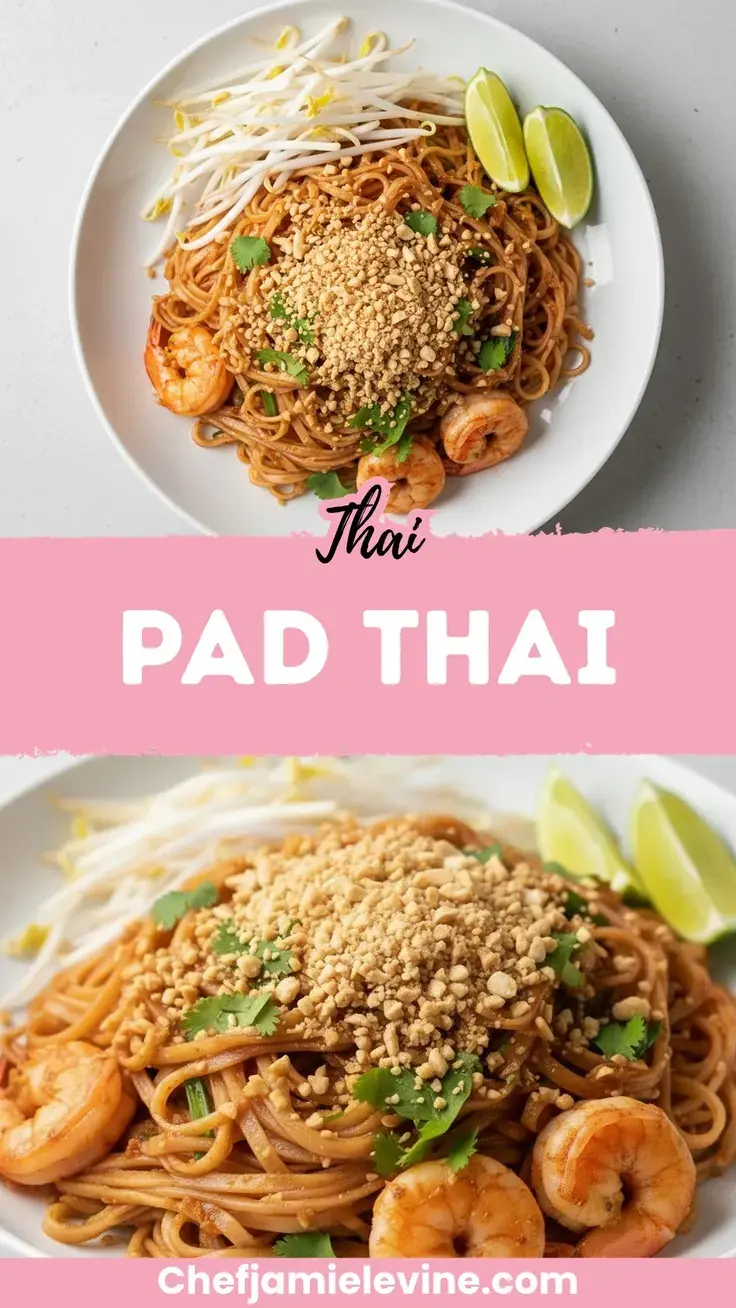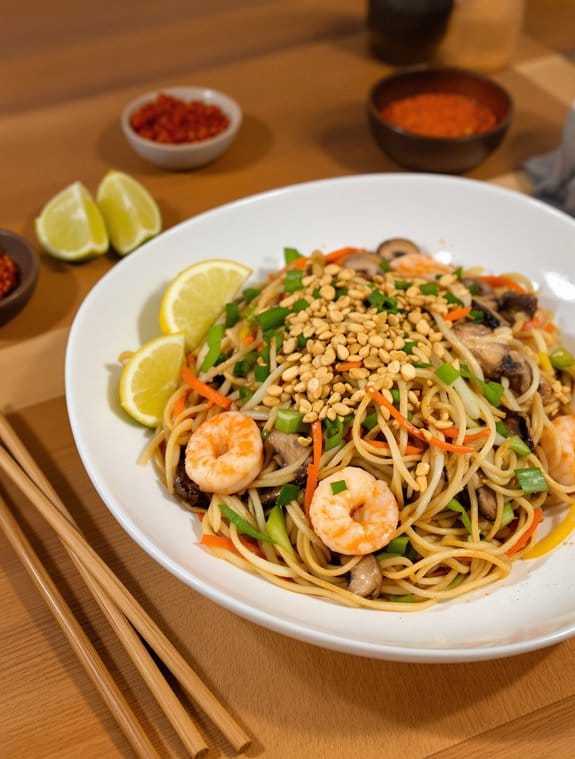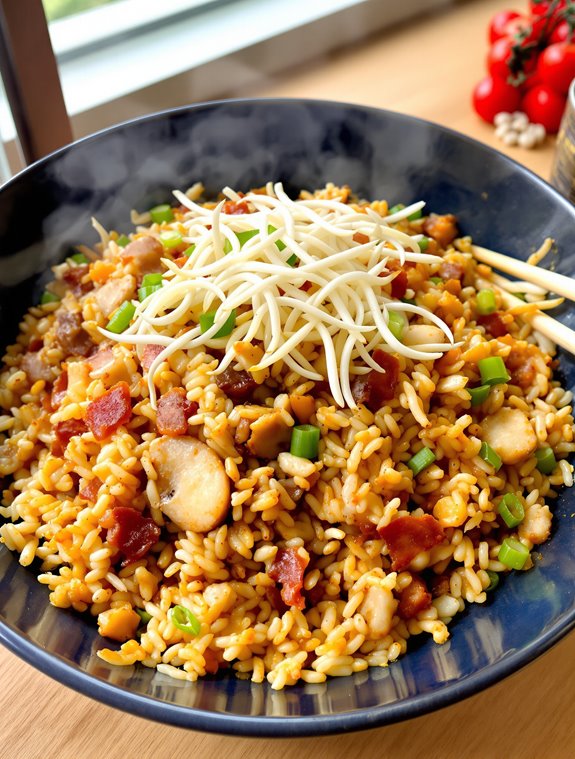Why You’ll Love this Authentic Pad Thai
If you’ve been searching for a taste of Thailand that won’t disappoint, I’m thrilled to share this authentic Pad Thai recipe that’s become my go-to weeknight wonder.
The balance of tangy fish sauce, sweet sugar, and acidic rice vinegar creates that unmistakable Pad Thai flavor you crave.
What makes this version special? It’s customizable yet faithful to tradition.
The protein duo of chicken and shrimp provides hearty satisfaction, while the crunchy peanuts and fresh bean sprouts add textural contrast in every bite.
Trust me, once you master this recipe, takeout will become a distant memory.
The lime wedges? Non-negotiable for that perfect finishing touch.
What Ingredients are in Authentic Pad Thai?
Authentic Pad Thai is all about balance—sweet, sour, salty, and umami flavors dancing together in perfect harmony. This classic Thai street food has become an international favorite for good reason, and with the right ingredients, you can recreate that magical combination right in your own kitchen. The key is gathering everything before you start, as the cooking process moves quickly once your wok hits the heat.
- 6 tablespoons fish sauce
- 1/2 cup rice vinegar (unseasoned)
- 3 tablespoons tomato paste
- 1/2 cup sugar
- 8 ounces rice noodles (medium width)
- 2 eggs
- 2 1/2 tablespoons canola oil
- 5-6 garlic cloves, minced
- 1/4 cup baby carrots, julienned
- 4 ounces sliced mushrooms
- 5 green onions, chopped
- 1/2 lb boneless skinless chicken breast, cooked and cut into bite-size pieces
- 1/2 lb shrimp, cooked, peeled and deveined
- 3/4 cup dry-roasted unsalted peanuts, coarsely chopped
- 4 ounces bean sprouts
- 1 lime, cut into wedges
- Crushed red pepper flakes (optional)
When shopping for these ingredients, quality matters, especially with the fish sauce—it’s the soul of Pad Thai. Look for a good Thai brand if possible. For the noodles, traditional rice sticks labeled “medium” work best, as they hold up to stir-frying without breaking apart. And don’t skip the fresh lime or bean sprouts, which might seem like mere garnishes but actually provide significant brightness and crunch that elevate the entire dish. If you’re cooking for those with peanut allergies, sunflower seeds can make a decent substitute for the chopped peanuts.
How to Make this Authentic Pad Thai

Making Pad Thai at home is surprisingly straightforward—it’s all about preparation and timing. Start by mixing your sauce ingredients: 6 tablespoons fish sauce, 1/2 cup rice vinegar, 3 tablespoons tomato paste, and 1/2 cup sugar. This flavor-packed mixture needs to be ready before you start cooking because once you heat that wok, things move quickly.
Meanwhile, prepare your 8 ounces of rice noodles according to package directions, but aim for slightly al dente since they’ll continue cooking in the wok later.
Next comes the layering of flavors that makes Pad Thai so irresistible. Scramble 2 eggs in your skillet or wok until fully cooked, then set them aside. Add 2 1/2 tablespoons of canola oil to the hot pan, then toss in your minced garlic (5-6 cloves), julienned carrots, and 4 ounces of sliced mushrooms, cooking for about 2-3 minutes until fragrant and slightly softened.
Pour in your prepared sauce, stirring to combine all those aromatic ingredients. Now for the protein—add your chopped green onions, scrambled eggs, bite-sized pieces of cooked chicken breast, peeled and deveined shrimp, and 3/4 cup of chopped peanuts. After a quick two-minute stir to heat everything through, it’s time for the finale: add those prepared rice noodles and 4 ounces of bean sprouts, cooking just two minutes more until everything’s gloriously mingled.
Serve with lime wedges for squeezing over top, and if you like heat, a sprinkle of crushed red pepper flakes. The whole process takes about 20 minutes from wok to table, but the flavors taste like they’ve been developing for hours.
Authentic Pad Thai Substitutions and Variations
While this classic recipe is a perfect starting point, Pad Thai’s beauty lies in its adaptability to what you have on hand.
Don’t have shrimp? Try tofu or double up on chicken.
Vegetarians can skip the fish sauce for soy sauce with a splash of lime.
I’ve been known to throw in whatever veggies are languishing in my fridge—broccoli, bell peppers, even zucchini.
For a lower-carb version, try spiralized zucchini noodles mixed with rice noodles.
Need it gluten-free? Just verify your fish sauce is certified. The noodles already are.
What to Serve with Authentic Pad Thai
A perfect Pad Thai deserves equally delicious companions on your table to round out the meal.
I love serving mine with fresh cucumber salad dressed in rice vinegar and a sprinkle of sugar—the cool crispness balances the noodles’ richness.
Thai spring rolls make wonderful appetizers, or try satay skewers with peanut sauce for protein lovers.
For beverages, nothing beats Thai iced tea or a cold lager.
My family always fights over my simple mango sticky rice dessert afterward.
Remember, good sides shouldn’t compete with your Pad Thai’s complex flavors, just complement them.
Balance is key, just like in the dish itself.
Final Thoughts
Beyond sides and pairings, I’ve found that mastering Pad Thai has taught me patience in the kitchen. There’s something magical about watching those rice noodles soak up that perfect balance of fish sauce, vinegar, and sweetness.
The true beauty of this dish lies in its adaptability. Don’t have shrimp? Use just chicken. Vegetarian? Swap in tofu and skip the fish sauce for soy.
Remember, the key is preparation—having everything ready before hitting that hot wok. The actual cooking happens so quickly, you’ll barely have time to think.
Trust me, your first attempt mightn’t be restaurant-quality, but keep trying. Each batch gets better.

Pad Thai
Ingredients
Equipment
Method
- Combine fish sauce, rice vinegar, tomato paste, and sugar in a bowl to create your sauce. Mix well and set aside.
- Prepare rice noodles according to package directions, aiming for slightly al dente texture as they’ll continue cooking later. Drain and set aside.
- Heat a portion of the canola oil in a large wok or skillet over medium-high heat. Scramble the eggs until fully cooked, then remove and set aside.
- Add remaining oil to the wok. Sauté minced garlic, julienned carrots, and sliced mushrooms for 2-3 minutes until fragrant and slightly softened.
- Pour the prepared sauce into the wok, stirring to combine with the vegetables.
- Add the chopped green onions, scrambled eggs, chicken pieces, shrimp, and chopped peanuts. Stir-fry for about 2 minutes to heat everything through.
- Incorporate the cooked rice noodles and bean sprouts, cooking for an additional 2 minutes until everything is well combined and heated through.
- Serve immediately with lime wedges for squeezing over top and crushed red pepper flakes on the side for those who enjoy extra heat.



